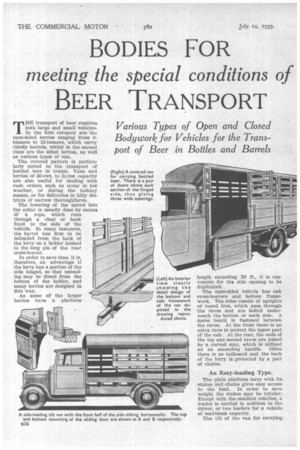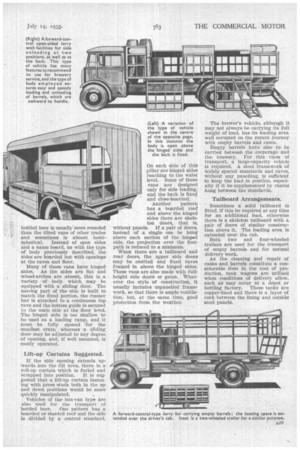BODIES FOR
Page 42

Page 43

If you've noticed an error in this article please click here to report it so we can fix it.
meeting the special conditions of
BEER TRANSPORT
Various Types of Open and Closed Bodywork for Vehicles for the Transport of Beer in Bottles and Barrels THE transport of beer requires both large and small vehicles. In the first category are the open-sided. lorries ranging froix* 3tonners to 12-tonners, which carry chiefly barrels, whilst in the second class are the sided lorries, as well as various types of van.
The covered pattern is particularly suited to the transport of bottled beer in crates. Vans and lorries of 30-cwt. to 2i-ton capacity are also useful for dealing with rush orders, such as occur in hot weather, or during the holiday season, or for deliveries in hilly districts or narrow thoroughfares.
The lowering of the barrel into the cellar is usually done by means of a rope, which runs through a cleat or hook fixed to the side of the vehicle. In many instances, the barrel has first to be unloaded from the back of the lorry on a ladder hooked to the long pin of the rear cross-bearer.
In order to save time, it is, ,therefore, an advantage if the lorry has a portion of the side hinged, so that unloading may be direct from the bottom of the ladder, and many lorries are designed in this way.
As some of . the larger lorries have a platform length exceeding 20 ft., it is convenient for the side opening to be duplicated.
The open-sided vehicle has oak cross-bearers and bottom framework. The sides consist of uprights of round iron, which pass through. the raves and are bolted underneath the bottom or main side. A name board is fastened between the raves. At the front there is an extra rave to protect the upper part of the cab. At the rear, the ends of the top and second raves are joined by a curved stay, which is utilized as an ascending handle. Often there is no tailboard and the back of the lorry is protected by a pair of chains.
An Easy-loading Type.
The plain platform lorry with its stakes and chains gives easy access to the load. In order to save weight the stakes may be tubular. Except with the smallest vehicles, a loader is carried in addition to the driver, or two loaders for a vehicle of maximum capacity. The tilt of the van for carrying bottled beer is usually more rounded than the tilted vans of other trades arid sometimes is almost hemispherical. Instead of open sides and a name board, as with the type of body previously described, the Sides are boarded but with openings at the raves and floor. . .
Many of these vans have hinged sides. As the sides are fiat and wheel-arches are absent, this is a -variety of body which may be equipped with a sliding door. The moving part of the side is built to match the fixed portion, the runner bar is attached to a continuous top rave and the bottom guide is secured to the main side at the floor level. The hinged side is too shallow to be used as a loading ramp, and it must be fully opened for the smallest crate, whereas a sliding door may be adjusted to any degree of opening, and, if well mounted, is easily operated.
Lift-up Curtains Suggested.
If the side opening extends upwards into the tilt area, there is a roll-up curtain which is furled and
strapped into position. It is suggested that a lift-up curtain fastening with press studs both in the up and down positions would be more quickly manipulated.
Vehicles of the box-van type are also used for the transport of bottled beer. One pattern has a boarded or sheeted roof and the side is divided by a central standard.
On each side of this pillar are hinged sides reaching to the waist level. Some of these vans are designed only for side loading, and the hack is fixed and close-boarded: Another pattern has a boarded roof and above the hinged sides there are skeleton doors, that is, without panels. If a pair of doors, instead of a single one be hung above each section of the hing‘d side, the projeetion over the footpath is reduced to a minimum.
When there are a tailboard and rear doors, the upper side doors may be omitted and fixed raves framed in above the hinged sides. These vans are also •made with fullheight side doors or gates. Whatever the style of construction, it usually includes unpanelled framework, so that there is ample ventilation, but, at the same time, good protection from the weather. The brewer's vehicle, although it may not always be carrying its full weight of load, has its loading area well occupied on the return journey with empty barrels and cases.
Empty barrels have also to be carried between the cooperage and the brewery. For this class of transport, a large-capacity vehicle is required. A steel framework of widely spaced standards and raves, without any panelling, is sufficient to keep the load in position, especially if it be supplemented by chains hung between the standards.
Tailboard Arrangements.
Sometimes a solid tailboard is fitted, if this be required at any time for an additional load, otherwise there is a skeleton tailboard with a pair of doors of similar construction above it. The loading area is extended over the cab.
Both two and four-wheeled trailers are used for the transport of empty barrels and for normal delivery work.
AK the cleaning and repair of casks and barrels constitute a considerable item in the cost of production, tank wagons are utilized when conditions of delivery allow, such as may occur at a depot or bottling factory. These tanks are copper-lined and there is a layer of cork between the lining and outside steel. panels..




























































































